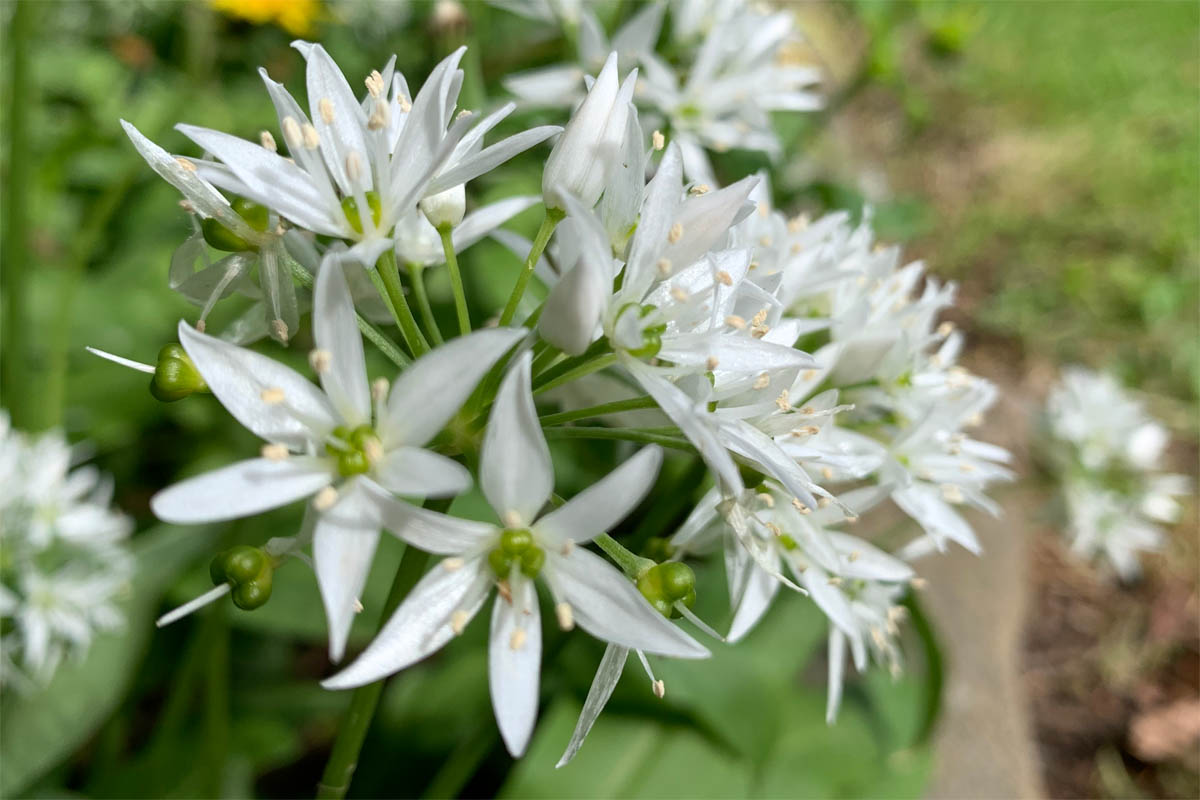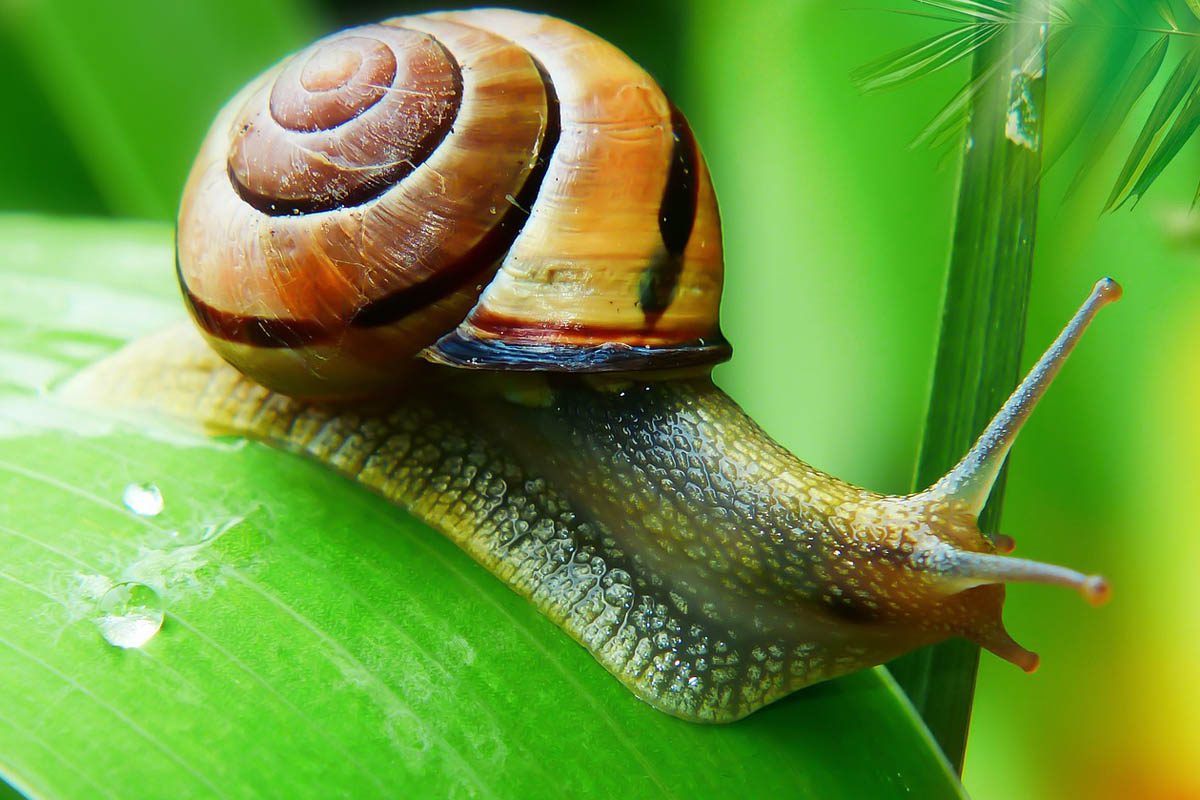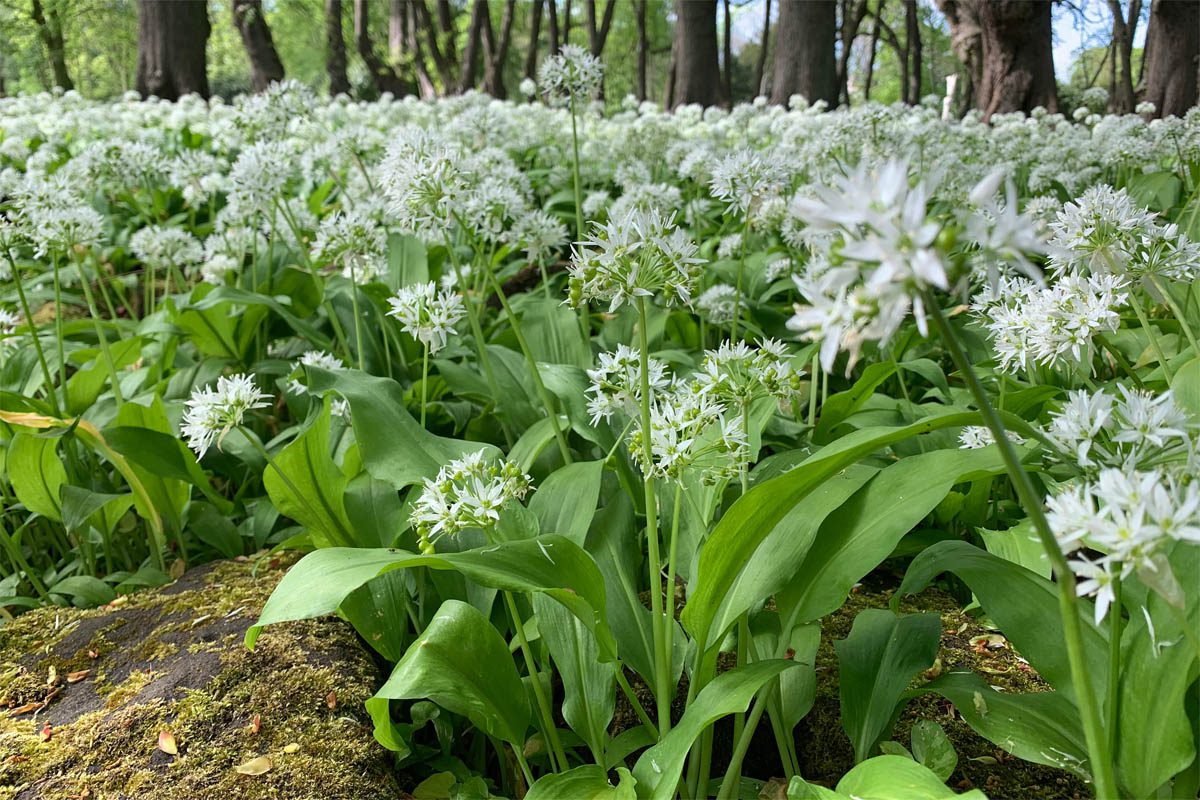What is wild garlic?
Also known as ramsons, or bear’s garlic, wild garlic (Allium ursinum L.) is a bulbous herbaceous perennial belonging to the Amaryllidaceae family. Native to the Europe and Asia, wild garlic has a long history of medicinal and dietary use. Its native habitat is moist, shaded areas such as woodlands and forests. In mid-spring, wild garlic carpets the ground with its broad, green leaves and star-shaped white flowers. The entire plant emits a pungent, garlic-like aroma, hence its common name.
I grew up in North Yorkshire, England and visit family every few years. Nothing reminds me more of my homeland than the sight and smell of wild garlic and English bluebells. During May, the woodlands are carpeted with both of these native beauties. In fact, bluebells and wild garlic are key indicators that a woodland is ancient.
The botanical name Allium ursinium his of Latin origin. “Allium” is the genus to which wild garlic, along with onions, leeks, and many other similar plants, belongs. Allium is Latin for garlic. The species name ursinium, comes from the Latin word ursus, which means bear and is believed to be due to the observation that bears would eat the plant after coming out of hibernation in spring. So, Allium ursinium is roughly translated to bear’s garlic.
Is wild garlic safe to eat?
Wild garlic contains vitamins A and C, calcium, phosphorous and iron. The leaves, flowers and bulbs of wild garlic are all edible and have a mild-garlic taste. Wild garlic has also been used in traditional medicine and has a number of potential therapeutic effects.
Compounds similar to those found in conventional garlic (Allium sativum) are present in wild garlic which may enhance the effects of blood-thinning and anticoagulant medications. These compounds include allicin, adenosine and ajoene which may inhibit platelet aggregation. Platelet aggregation is the process by which platelets adhere to each other to form clots. People taking anticoagulants or blood thinners such as warfarin or aspirin should seek the advice of their doctor before consuming wild garlic.
Is wild garlic the same as garlic?
Wild garlic (Allium ursinum) and garlic (Allium sativum) are different species of plant. However, they both belong to the same family. Garlic is widely grown commercially and the bulb of the plant is most commonly consumed. Wild garlic generally isn’t grown on a commercial scale, and the leaves are typically used.
| Wild garlic (Allium ursinum) | Cultivated garlic (Allium sativum) | |
|---|---|---|
| Physical characteristics |
Broad, flat, elliptical leaves, white star-shaped flowers, and small, elongated bulbs. |
Central stalk with long, flat leaves growing from a large, round bulb, made up of multiple cloves. |
| Growth habits | Woodland perennial growing in shady, damp environments. Often carpets the ground in the spring. |
Typically grown as an annual in sunny, well-drained garden beds or fields. |
| Flavour | Mild, sweet garlic flavour. |
Strong, pungent garlic flavour. |
| Culinary uses | Leaves are used in salads, pestos, and soups. Flowers are used as a garnish. | Cloves are used in a wide variety of dishes. Can be used raw, sautéed, roasted, or even fermented (as in black garlic). Scapes are used in stir-fries and pestos. |
Description

Wild garlic grows from a bulb and forms dense clumps of leaf rosettes and later on, star-shaped, white flowers in woodland habitats. The leaves appear in late winter followed by white, star-shaped flowers. The plant reaches a height of 30 cm.
Leaves:
The leaves are broad, long, and elliptical, and can grow up to 25 cm long. They have a vibrant green colour, are shiny on the upper side and matt on the underside. The leaves grow in basal rosettes from the bulb, and are tender to touch. When bruised, they emit a mild garlic-like scent.
Flowers:
Wild garlic produces flowers in late spring. Each plant forms a solitary stem that rises above the leaves on a single stem in a pherical cluster known as an umbel. The umbel contains several flowers, each with six white petals forming a star-shape.
The flowers have both male and female reproductive organs (hermaphrodite), and are pollinated by bees and other insects. Following pollination, a three-sided pod develops which eventually darkens and dries out as it matures.
Bulbs:
The bulbs are small, white, round or slightly elongated and are encased in a thin, papery covering known as a tunic. Bulbs are modified stems that serve as storage organs for the plant. In the right conditions, these bulbs can split and multiply, a form of asexual reproduction that can result in large colonies of wild garlic.
Difference between wild garlic and lily of the valley

For people who forage, it is important to know the difference between lily of the valley and wild garlic. Lily of the valley produces similar strap-like leaves in spring but is highly toxic. The toxic property is convallarin, a cardiac glycoside.
Both plants can be found growing in a similar woodland habitat, and their leaves are similar. The presence or absence of a garlic-like smell when the leaf is crushed is the most prominent feature. Only wild garlic emits this scent.
| Feature | Wild Garlic | Lily of the Valley |
|---|---|---|
| Family | Amaryllidaceae | Asparagaceae |
| Native To | Europe and Asia | Northern Hemisphere |
| Leaves | Broad, flat, elongated leaves growing from the base |
Elliptical to lanceolate leaves growing from a single stem |
| Scent | Distinctive garlic scent, especially when crushed | No garlic scent, flowers are sweetly fragrant |
| Flowers | Star-shaped, white flowers in a round umbel (cluster) |
Tiny, bell-shaped, white or pale pink flowers hanging down in a raceme |
| Flowering time | Late spring (Apr-June in the Northern Hemisphere) | Late spring (May-June in the Northern Hemisphere) |
| Fruit/Seed | Forms a green seed pod with black seeds |
Forms a red or orange berry |
| Edibility | The entire plant is edible and commonly used as a food source | The entire plant is poisonous |
Sowing wild garlic seeds

Wild garlic seeds can be purchased from a reputable nursery or online.
When to sow: The seeds should be sown in autumn (fall), to reflect the plant’s natural lifecycle. Autumn sowing allows the seeds to go through a chilling period called ‘cold stratification’ which is crucial for the seeds to break dormancy and germinate. If you are unable to sow in autumn, you can artificially stratify the seeds in a refrigerator for a month.
It is important to remember that it can become quite prolific and may crowd out other plants. In a garden setting, consider containing it within or growing it in pots to control its spread.
Waiting for germination: patience is required
The key to successful germination is patience and consistent care. Some seeds germinate quickly, while others take much longer, even under the same conditions. Wild garlic seeds can remain dormant for 1-2 years. This extended period of dormancy is a natural survival strategy that helps the plant survive unfavourable conditions.
Breaking dormancy starts with stratification, a period of cold, moist conditions that can be facilitated by sowing the seeds in autumn, and allowing winter to provide the necessary cold period. However, even with stratification, seeds may take a considerable amount of time before they germinate.
This long wait can test even the most patient gardener and it is tempting to give up. But, it is crucial to maintain consistent care and keep the soil moist at all times. Even though you can’t see any activity above ground, there is a lot happening beneath the surface.
Once the seeds have germinated, protect them from harsh weather and pests. It will take another few years for the seedings to reach maturity and produce flowers.
It is also important to remember that wild garlic is a perennial, once it establishes, it will return year after year and reward you with a long-lasting, low-maintenance plant.
Life cycle

Wild garlic is a perennial plant which means it lives for several years. In winter, wild garlic lies dormant in its below-ground bulb. The bulb is a storage organ that allows plants to store nutrients and energy during the unfavourable conditions of winter. As temperatures rise and the days become longer, wild garlic begins to sprout, sending up broad, shiny green leaves which carpet the ground in areas where it grows densely.
The leaves are followed by a single, spherical umbel (cluster) of small, white, star-shaped flowers on a solitary stem. After flowering, the plant produces green seed pods which contain the seeds. At maturity in early summer, the pods open to release their seeds, which fall to the ground and germinate the following year. After flowering and seed production, the leaves die back in mid-summer, and the plant goes into a state of summer dormancy. As the leaves die back, they provide energy, which is stored in the bulb for the next growing season. Wild garlic remains dormant during late summer, autumn and winter.
This cycle repeats each year, with wild garlic plants potentially spreading further if conditions are favourable. Over time, the original bulb produces new bulbs, known as offsets or daughter bulbs. These form alongside the original bulb, growing from the base of the mother bulb.
It takes 4-5 years for wild garlic to reach sexual maturity and an average lifespan of 8-10 years.
Care and maintenance of wild garlic
| Climate | Cold, temperate, sub-tropical |
| Soil | Light to medium, organically-rich, damp, but well-drained soils with a pH range of 5.8-6.8.
Prepare the garden by adding compost or well-rotted manure to improve the nutrient content and structure. |
| Sowing depth and spacing | Sow at a depth of 4 mm and 10 cm (4 inches) apart. This will allow each plant enough space without competition for water and nutrients. |
| When to sow | Autumn/early winter (cold stratification required if sown outside this period) |
| Germination time | 2-3 weeks for older seeds to 1 year for young seeds |
| Location | Wild garlic naturally grows in woodlands and prefers locations with partial to full shade. While it can tolerate some sunlight, avoid direct sunlight. |
| Moisture levels | Wild garlic tends to grow in areas of consistent moisture. Choose a location that isn’t prone to drying out, however, the soil should be well-draining to prevent waterlogging. |
| Leaf colour | Green |
| Flower colour | White |
| Height | 30 cm |
| Toxicity | Toxic to pets in large amounts |
| Temperature ranges | -28 to 32°C (-18 to 90°F) |
| Fertilising | Typically doesn’t require much fertilization, particularly if it’s planted in rich, well-composted soil |
| Companion plants | Wild garlic grows well well with other woodland and shade-loving plants such as bluebells, ferns, Solomon’s seal, wood anemone and hosta. |
Pests and diseases

Pests:
- Slugs and snails: These can sometimes be a problem, especially in wet and humid conditions. Handpick them off the plants, use slug traps (beer in a cup works well), or consider using an environmentally-friendly slug repellent. Always be careful using snail and slug treatments around pets and children.
- Onion fly: Onion flies (Delia antiqua) are known to affect members of the Allium family. The female lays her eggs at the base of the plant, and the emerging larvae then burrow into the bulb, causing damage.
Diseases:
- White rot: White rot is a fungal disease caused by Sclerotium cepivorum that affects the Allium family. Symptoms of white rot include yellowing, wilting and dieback of the leaves. Leaf decay begins at the base of the outer leaves, causing the leaf to collapse. Once a plant is infected, it cannot be cured and should be removed to prevent the spread.
- Downy mildew: A fungal disease caused by Peronospora sparsa that can occasionally affect wild garlic, causing discoloured patches on leaves. Management includes improving air circulation around plants and avoiding wetting leaves when watering. Fungicides can be used if the problem persists.
Maintaining good garden hygiene, ensuring adequate space for air circulation and regularly checking plants for signs of pests or disease can help to reduce pests and diseases. Be careful to not overwater your wild onion as this can contribute to fungal diseases. Always remove affected plants and do not compost.
When to harvest wild garlic
Wild garlic grows from early spring until mid-summer, at which point the leaves die back. Leaves are at their most tender before the flowers bloom. The flowers are also edible, with a milder and sweeter flavour. They can be used in salads or dried to make a flavoured salt.
Never pick more than you need and do not remove more than a third of the leaves from each plant. The leaves can be carefully cut off with a pair of scissors or a sharp knife. Harvest the leaf from its base where it connects to the stem, not from the middle or the tip. Place the leaves in a basket or a breathable bag. Avoid stuffing them into a tight space which could cause pressure and result in bruising. Do not pull on the plant as you may displace the bulb and kill the plant.
Wild garlic leaves are delicate and best used soon after picking. The longer they are stored, the more likely they are to bruise or wilt.
Storing wild garlic
Store in leaves the salad crisper in the refrigerator for up to three days. The flowers are best consumed on the same day.
Is it illegal to take wild garlic?
In the United Kingdom, it is legal to forage for wild garlic, however, it is illegal to dig up the bulb, which will prevent the plant from returning the following year. Simply snip off the foliage and some (not all) leaves, and leave the bulb intact.
It is illegal to forage on private property without the landowner’s permission, no matter what you are collecting.
Even where it is legal to forage, it is important to do so responsibly to protect the environment and ensure that the plants can continue to grow in the future. Do not take more than you need and be careful not to damage the plant or its habitat.
It is a good idea to check the specific regulations in your area or consult with a local naturalist or foraging group before foraging.
Wild garlic recipes
Wild garlic soup |
Ingredients:
Instructions:
|
Wild garlic pesto |
Ingredients:
Instructions:
|
Wild garlic and goat cheese tart |
Ingredients:
Instructions:
|
Wild garlic hummus |
Ingredients:
Instructions:
|
Wild garlic and potato gratin |
Ingredients:
Instructions:
|
Wild garlic risotto |
Ingredients:
Instructions:
|
Wild garlic and mushroom pasta |
Ingredients:
Instructions:
|
Julia is a writer and landscape consultant from Wollongong with a love of horticulture. She had been an avid gardener for over 30 years, collects rare variegated plants and is a home orchardist. Julia is passionate about learning and sharing her knowledge of plant propagation and plant toxicology. Whether it’s giving advice on landscape projects or sharing tips on growing, Julia enjoys helping people make their gardens flourish.




